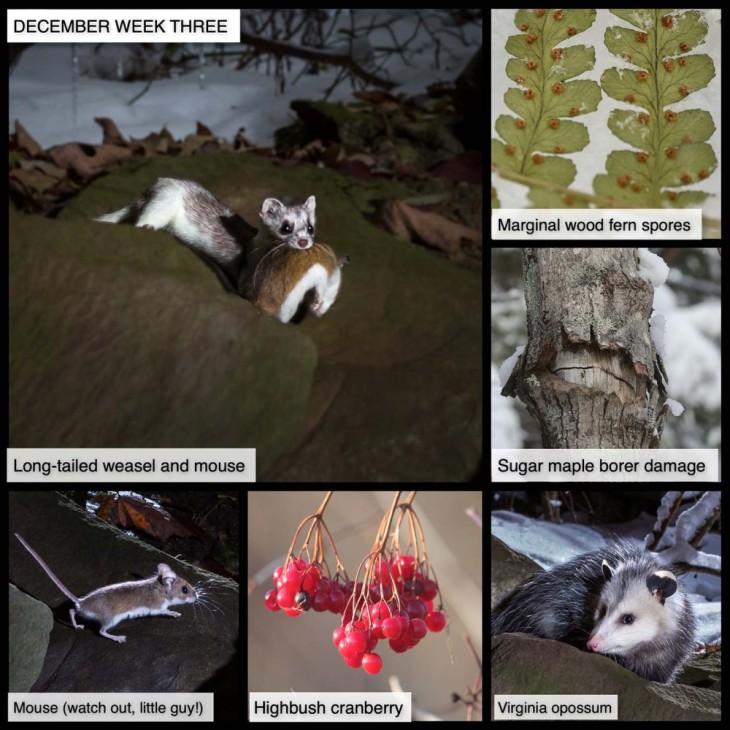This Week in the Woods, our shed camera trap project revealed a beautiful weasel, probably a long-tailed weasel, in the act of carrying off its mouse prey. Weasels are relatively new animals. They evolved during the ice ages as snow tunnel predators, and although they’ll hunt other animals, their specialty is catching mice in small spaces. As noted in this Outside Story essay from our archive, “They’re small – even an adult male long-tailed weasel has a skull that measures at most a little over an inch at its widest point – and anywhere the head can go, the rest of the body can go, too. Weasels’ hips and shoulders are narrow. They have thin coats and little in the way of fat. Their spines are exceptionally flexible, and their legs are stubby, which means that they don’t require much room to push their bodies forward.” Weasels also have perfectly aligned bites that instantly snap mouse spines, and powerful necks, as you can see in this photo – another mouse hunting adaptation that enables them to carry their prey through narrow spaces where there isn’t room to drag a carcass. Note also the mottled fur. This weasel seems to have timed its coat change just right, transitioning from brown to white just as our first real snows arrived.
Here are some other nature sights (clockwise):
Both marginal wood fern and intermediate wood fern, also called evergreen wood fern, remain green in the winter. Their names refer to the placement of the spore cases on the underside of the leaflets; in marginals, as shown in this photo, the spore cases appear on the outer edges. Here’s an Outside Story essay by Sandra Mitchell describing wood ferns and two other evergreen ferns you’ll find in the snowy woods: Christmas ferns and polypody ferns (two species). The essay includes the surprising fact that intermediate wood ferns can, “secrete a toxic substance which can paralyze some cold-blooded animals and invertebrates.”
Why is this tree frowning? You would too, if you had sugar maple borer larvae tunneling through your cambium. These native long-horned wood boring beetles scar, but don’t typically kill, sugar maples. Here’s a previous post, including an image of another frowny-faced tree.
Put another point on the board for our shed camera trap! We’ve discovered that at least two Virginia opossums are hanging out in the shed, no doubt taking shelter from harsh winter weather that they’re not really built to endure. Opossums, our only native North American marsupials, have moved back into the northern parts of the continent over the past few decades, helped along by humans who provide lots of extra food for these omnivores to scrounge, and human shelters such as barns, garages, and other outbuildings. People often compare opossums’ looks to rats, but they’re not at all closely related to rodents, and they have a number of remarkable features: resistance to snake venom, prehensile tails, an ability to “play dead” (including emitting rank smelling substances), and, hurray, a habit of hoovering up ticks as they groom. Here’s an Outside Story essay by Decan McCabe that describes their northward movement, and a second fun Outside Story essay about opossums by Kenrick Vezina, with the provocative title, “Live Weird, Die Young.”
Highbush cranberry is such a beautiful sight this time of year. You’ll find it growing in various locations, but a typical habitat is in a damp, sunny area. This member of the viburnum family (so, not a true cranberry) is a source of red native berries that birds and other wildlife are slow to eat, but gobble up in winter, probably as they become less acidic. Here’s a University of Maine Extension profile about them.
And finally, it only seems fair that we acknowledge the other guy in our lead photo. We don’t know if this is the same mouse that met a weaselly end, but based on many other photos, we can assure worried readers that the shed is not facing a mouse shortage. There are two look-alike mouse species that you’re likely to see this time of year: deer mice and white-footed mice. As noted in this Outside Story essay by Michael Caduto, white-footeds are typically more reddish brown, with dark stripes along their backs. Our best guess is that both of this post’s mouse images show white-footed mice, but individuals vary, and as with the weasels, it’s tricky to make an identification based on just one photo. Both species cache seeds and nuts (another photo showed a small mouse carrying a big acorn).
Our thanks to The Bailey Charitable Foundation and the Frank and Brinna Sands Foundation for helping to support this series.
In this difficult period, many of us find joy in observing local nature. This series, launched in April 2020, shares nature photographs taken in the past seven days, or in the same week in 2020, most within 15 miles of the Northern Woodlands office in Lyme, New Hampshire. We hope you enjoy using this grid as a prompt for your own explorations.
What are you seeing in the woods this week? Share your images with us on Facebook, or submit a special photo for possible inclusion in our monthly online Reader Photo Gallery.


